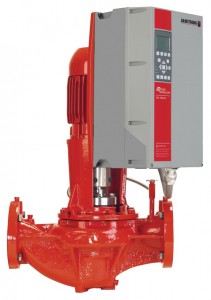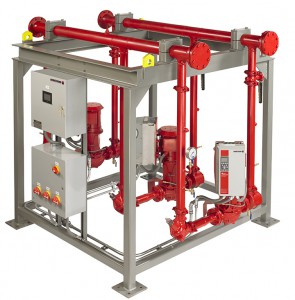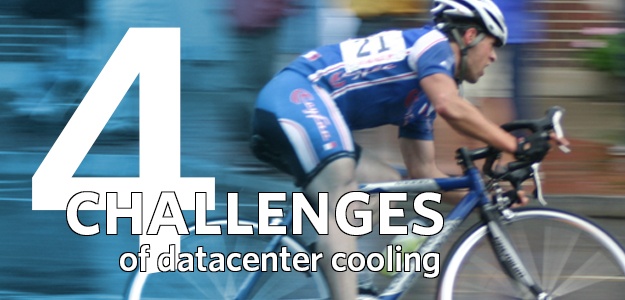 By Dominic Cutts
By Dominic Cutts
Director – System Solutions at Armstrong Fluid Technology
Datacenters present the HVAC system designer with a number of challenges. Cooling loads are significantly higher than other commercial buildings, and there are specific demands relating to the sizing of equipment and the shorter-than-average upgrade cycle. Most importantly, system designers face a raft of regulatory guidelines around the energy efficiency performance of data centres, and the systems they specify are scrutinised closely throughout their lifecycles. So how do these challenges impact on design strategy?
Challenges
- Higher cooling loads: Increasing use of advanced IT technologies, such as blade servers and virtualisation, is escalating overall energy demand of datacenters by between 5% and 10% a year. In addition to the energy use of the IT equipment itself, generation of heat is an unavoidable outcome of electrical resistance within the processors and, as processors become more powerful, the demand for cooling rises incrementally. Dissipating this heat is essential for reliable operation and as much as 45% of the energy costs of a data centre can relate to its HVAC system.
- Avoiding over-sizing: Datacenter operators benefit from scaling up IT processing capacity incrementally in line with demand. This provides a more effective Return On Investment than designing in over-capacity. This conflicts, however, with traditional HVAC best practice, whereby systems are designed to accommodate maximum building load from the outset. Operating over-sized HVAC plant reduces energy efficiency performance considerably.
- Shorter upgrade cycles Many HVAC cost-savings are calculated across the equipment’s comparatively long lifecycle. The shorter upgrade cycles of datacenter cooling systems, however, demand more aggressive value engineering propositions and lead times which reflect the entrepreneurial nature of the sector.
- Regulation and transparency: A number of international bodies are focusing on energy efficiency regulation and guidance for buildings of this type. The EU Code of Conduct on Datacenters' Energy Efficiency, for example, has the dual aim of reducing the carbon footprint of datacenters at the same time as improving IT system reliability and security. It provides guidelines for both the energy used within the IT system for processing, and for building services related energy usage, for cooling systems etc.
In a separate initiative, The Green Grid Association (a non-profit, open industry consortium of end users, policy makers, technology providers, facility architects, and utility companies) has developed a metric measurement methodology. The PUE™ (Power usage effectiveness) metric provides a benchmark that the environmental performance of every datacenter can be measured against. It provides an at-a-glance picture of the efficiency of the energy consumed in the building both for processing and for cooling. A PUE of 1.5, for example, means that for every unit of power used on core IT equipment, an additional 0.5 units is spent on the supporting infrastructure.[1]
As the power for core IT is difficult to reduce without impacting on processing capability, it is the infrastructure/HVAC part of the metric which comes under greatest scrutiny.
Solutions
There are a number of new approaches to HVAC design and build that can address these challenges.
 Demand based control: Traditionally, chilled water systems are designed around independent control loops with PID feedback, but these capacity based control systems are insufficient to achieve the PUE’s required for datacenter cooling. In contrast, demand based control methodologies such as Hartman LOOP™ digital relational control, are capable of treating the entire system ‘holistically’, rather than as individual sub-systems.
Demand based control: Traditionally, chilled water systems are designed around independent control loops with PID feedback, but these capacity based control systems are insufficient to achieve the PUE’s required for datacenter cooling. In contrast, demand based control methodologies such as Hartman LOOP™ digital relational control, are capable of treating the entire system ‘holistically’, rather than as individual sub-systems.
This provides a number of benefits. For example, key energy consuming components, such as Armstrong Design Envelope pumps can be sequenced to operate along their natural curve for all load conditions. In addition, Hartman LOOP can calculate and determine the best power relationships between the chiller, condenser pump and tower fan. This ensures the efficiency of individual components as well as optimizing power relationships across the system, with equipment loading in one device traded off to pick up more load on another. This achieves the same net “tonnage” for a lower kW input (a COP of greater than 7.0 compared to previous averages of between 3.2 and 2.2), delivering the kind of PUE’s needed by datacenters.
-
 Modular systems: The problems of over-sized plant can be avoided by specifying modular design HVAC systems. Additional cooling capability can be simply ‘bolted on’ to the existing plant in line with increasing IT processing capacity. This enhances the datacenter operator’s profitability by avoiding front-loaded capital investment. The Armstrong iFMS is a good example of a modular HVAC solution. It is a pre-designed, off-site manufactured pump package that is fully-configurable to suit the application. As it is an ‘off-the-shelf’ product, rather than a bespoke solution, it satisfies the demand for predictability and the same environmental performance, which are crucial in datacenter cooling.
Modular systems: The problems of over-sized plant can be avoided by specifying modular design HVAC systems. Additional cooling capability can be simply ‘bolted on’ to the existing plant in line with increasing IT processing capacity. This enhances the datacenter operator’s profitability by avoiding front-loaded capital investment. The Armstrong iFMS is a good example of a modular HVAC solution. It is a pre-designed, off-site manufactured pump package that is fully-configurable to suit the application. As it is an ‘off-the-shelf’ product, rather than a bespoke solution, it satisfies the demand for predictability and the same environmental performance, which are crucial in datacenter cooling. - Off-site manufacture: Specifying solutions which are entirely, or partially, pre-assembled off-site can also provide the system designer with a more aggressive value engineering proposition for datacenter clients. Off-site manufacture meets demanding project schedules, both for new facilities and upgrades systems of existing sites, by removing the assembly of the cooling infrastructure from the project’s critical path. Armstrong IPS (Integrated Pumping Systems) for example, reduce time to market significantly for new facilities.
Assembling, integrating and testing a complete chilled water plant room, or pump package, in the factory, rather than on-site, also provides the best possible guarantee of system integrity – a crucial factor in datacenter up-time. Armstrong’s self-contained IPP-CHW fully-integrated chilled water plant package is a popular example of this approach.
In conclusion, while datacenters pose design challenges for the HVAC engineer, approaches such as demand-based control, modular system design and off-site manufacture can address these requirements.
[1] AMA Research, ‘UK Data Centre Construction Market Report’, February 2014




